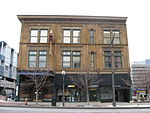Bricker Federal Building
1977 in OhioBrutalist architecture in OhioBuildings in downtown Columbus, OhioFederal buildings in the United StatesGovernment buildings completed in 1977 ... and 2 more
Government buildings in Columbus, OhioPost office buildings in Ohio

The John W. Bricker Federal Building is a federal office building in Downtown Columbus, Ohio. The structure was designed in the Brutalist architecture style and was built in 1977 to house federal offices. It has seven stories, and is part of a 454,000 sq ft (42,200 m2) facility, including an eight-story parking garage.The building is named for John W. Bricker, an Ohio governor and U.S. senator who lived in Columbus.
Excerpt from the Wikipedia article Bricker Federal Building (License: CC BY-SA 3.0, Authors, Images).Bricker Federal Building
East Spring Street, Columbus
Geographical coordinates (GPS) Address Nearby Places Show on map
Geographical coordinates (GPS)
| Latitude | Longitude |
|---|---|
| N 39.966688 ° | E -83.001001 ° |
Address
E Spring St & N High St
East Spring Street
43215 Columbus
Ohio, United States
Open on Google Maps









